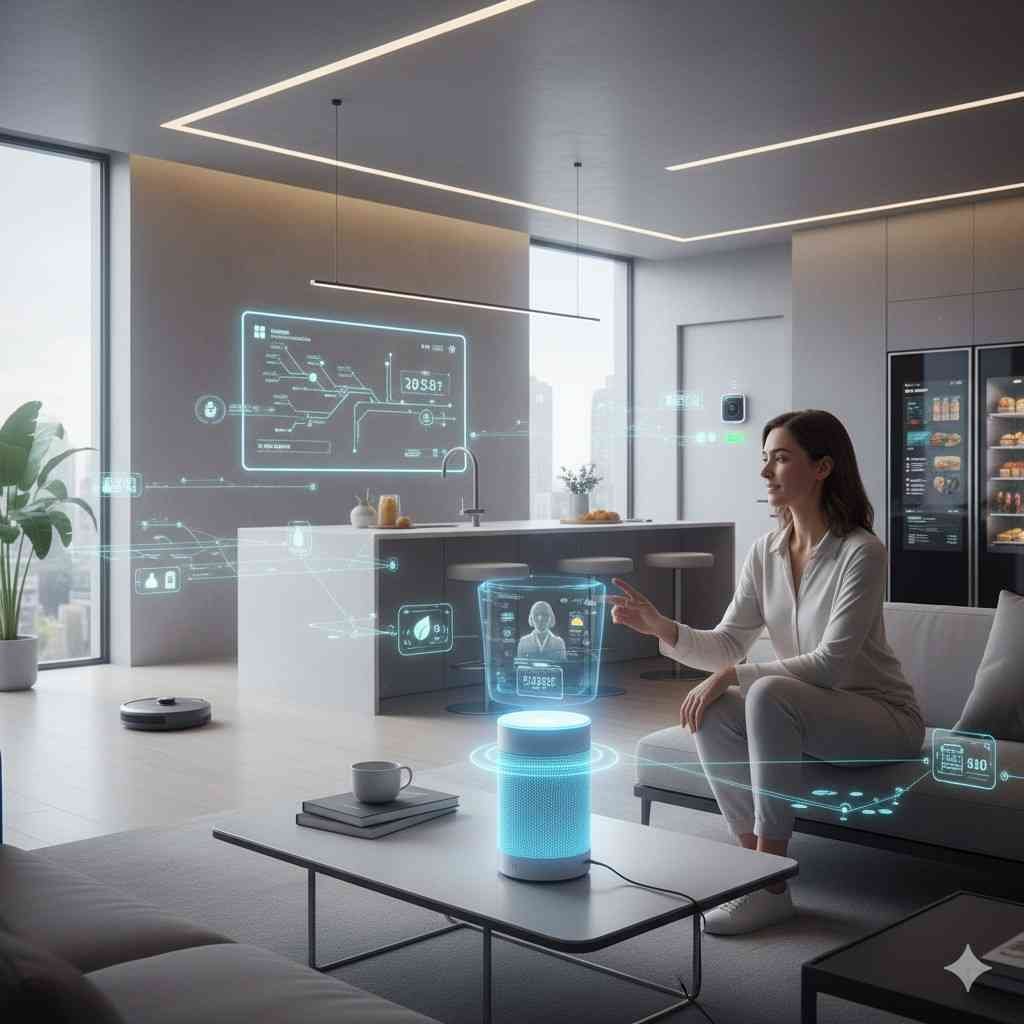
Top 5 Smart Home Devices to Buy in 2025
Smart home technology has reached a tipping point. What once seemed like science fiction has become accessible, affordable, and genuinely useful for everyday living. The global smart home market is projected to reach $537 billion by 2030, driven by advances in artificial intelligence, improved connectivity, and growing consumer demand for convenience and energy efficiency.
But here’s the challenge: with thousands of smart devices flooding the market, choosing the right ones for your home can feel overwhelming. Many devices promise revolutionary features but deliver mediocre performance, leaving homeowners frustrated with gadgets that complicate rather than simplify their lives.
The difference between a smart home that enhances your daily routine and one that becomes a source of constant troubleshooting lies in selecting proven, high-quality devices that integrate seamlessly with your lifestyle. After extensive research and real-world testing, we’ve identified five standout smart home devices that deliver genuine value in 2025.
These aren’t just the newest releases or the most heavily marketed products. They’re the devices that consistently perform, offer meaningful benefits, and represent the best intersection of innovation, reliability, and user experience available today.
Smart Speakers and Displays: The Command Center Revolution
Smart speakers have evolved far beyond simple voice assistants. The latest generation combines superior audio quality with advanced AI capabilities, making them the natural hub for controlling your entire smart home ecosystem.
Amazon’s Echo Show 15 leads the pack with its 15.6-inch display that functions as a family command center. Unlike smaller smart displays that require you to approach them, the Echo Show 15’s large screen remains visible from across the room. The device excels at managing family schedules, displaying security camera feeds, and controlling multiple smart home zones simultaneously.
What sets this device apart is its visual ID feature, which recognizes different family members and personalizes the display accordingly. When your teenager walks by, they see their homework assignments and music playlists. When you approach, the screen shifts to your calendar, weather updates, and smart home controls.
Google’s Nest Hub Max offers a compelling alternative with superior integration for Android users and Google services. Its camera includes advanced motion detection and can distinguish between people, packages, and pets—a feature that proves invaluable for home security and package monitoring.
The key advantage of smart displays over traditional smart speakers lies in their ability to provide visual feedback. When adjusting your smart thermostat or checking security cameras, seeing the information eliminates guesswork and confirms your commands were executed correctly.
For homes with multiple users, these devices shine as centralized information hubs. Shared shopping lists, family photos, video calls with grandparents, and coordinated smart home controls all become more accessible when managed through a single, always-visible interface.
Intelligent Climate Control: Beyond Basic Thermostats
Smart thermostats represent one of the most immediately beneficial smart home investments, typically reducing heating and cooling costs by 10-23% according to EPA studies. However, the best smart home devices go beyond simple scheduling to offer predictive climate management that adapts to your household patterns.
The Ecobee SmartThermostat with Voice Control stands out for its room sensor technology. Traditional thermostats measure temperature at a single point, often leading to uneven heating and cooling throughout your home. Ecobee’s remote sensors monitor temperature and occupancy in multiple rooms, ensuring comfort where you actually spend time while avoiding energy waste in empty areas.
This device integrates Amazon Alexa directly, eliminating the need for a separate smart speaker in your main living area. The built-in air quality monitor alerts you when indoor pollutants reach unhealthy levels, particularly valuable for families with allergies or respiratory sensitivities.
Google’s Nest Learning Thermostat takes a different approach, using machine learning to automatically create temperature schedules based on your behavior patterns. After a few weeks of normal use, the device begins anticipating your preferences and adjusting temperatures before you realize you need them changed.
The Nest’s Farsight feature activates the display when it detects movement from across the room, showing time, temperature, or weather information. This seemingly minor detail transforms the thermostat into a useful information display that justifies its prominent wall placement.
Both devices offer geofencing capabilities, automatically adjusting temperatures when you leave home and preparing your desired environment before you return. The energy savings from this single feature often justify the entire cost of the smart thermostat within the first year.
For homes with complex HVAC systems, these smart thermostats provide detailed energy usage reports and maintenance reminders, helping prevent costly repairs and ensuring optimal system performance.
Advanced Security Solutions: Peace of Mind Redefined
Home security has transformed from basic alarm systems to comprehensive monitoring solutions that leverage AI, cloud storage, and mobile connectivity. The best smart home devices in this category offer professional-grade security with user-friendly interfaces that make monitoring your property effortless.
Ring’s Video Doorbell Pro 2 exemplifies how smart security devices should work. Its dual-camera system provides both close-up facial recognition and wide-angle property monitoring, eliminating blind spots that plague single-camera designs. The device’s Bird’s Eye View feature creates aerial maps of detected motion, showing exactly where people travel around your property.
What distinguishes this doorbell from cheaper alternatives is its advanced motion detection algorithms. The device learns to differentiate between people, animals, vehicles, and packages, sending relevant alerts while filtering out false positives like swaying trees or passing shadows.
Arlo’s Pro 4 wireless security cameras complement doorbell monitoring with flexible placement options and exceptional image quality. These cameras operate on rechargeable batteries with six-month life spans, making installation possible anywhere around your property without running power cables.
The cameras’ color night vision capabilities reveal details that traditional infrared systems miss, while integrated spotlights deter intruders and improve recording quality during nighttime events. Built-in sirens provide immediate deterrent effects and can be triggered manually through the mobile app.
Arlo’s smart detection features recognize familiar faces, reducing unwanted notifications while ensuring you’re alerted to genuine security concerns. The system integrates with major smart home platforms, enabling automated responses like turning on lights when motion is detected after dark.
For comprehensive home monitoring, these security devices work together to create overlapping coverage zones. When someone approaches your property, the outdoor cameras detect and begin recording before they reach your doorbell, providing complete documentation of any security event.
Smart Lighting Systems: Illumination Intelligence
Smart lighting extends far beyond remote-controlled bulbs. The latest systems offer automated scheduling, circadian rhythm optimization, and security integration that transforms how your home responds to daily activities and seasonal changes.
Philips Hue’s latest ecosystem demonstrates the potential of truly smart lighting. The system’s daylight sensors automatically adjust brightness and color temperature throughout the day, supporting your natural circadian rhythms while reducing eye strain during evening activities.
Hue’s motion sensors enable room-by-room automation that learns your movement patterns. Lights turn on as you enter spaces and gradually dim when areas remain unoccupied, providing convenience while reducing energy consumption. The system’s gradual wake-up feature slowly increases bedroom lighting before your alarm, making mornings more pleasant and natural.
LIFX takes a different approach with individual bulbs that don’t require a central hub. Their Clean feature uses specific light wavelengths to reduce bacteria and viruses on surfaces, adding a health benefit to standard illumination. The bulbs’ exceptional brightness capabilities make them suitable for task lighting in work areas and kitchens.
Both systems excel at security lighting applications. Vacation modes simulate normal occupancy patterns while you’re away, randomly turning lights on and off in realistic sequences. Integration with security cameras and motion detectors enables immediate illumination during potential security events.
The energy efficiency of modern LED smart bulbs makes whole-house upgrades economically viable. Many utilities offer rebates for LED installations, and the bulbs typically pay for themselves through reduced electricity costs within two years.
Smart lighting also enhances entertainment experiences. Movie modes dim lights automatically when you start streaming content, while music sync features create dynamic light shows that respond to audio in real-time.
Robotic Cleaning Revolution: Autonomous Home Maintenance
Robotic vacuum cleaners have matured from novelty gadgets to genuinely useful cleaning appliances. The best models combine powerful suction with intelligent navigation and app-based controls that make maintaining clean floors effortless.
iRobot’s Roomba j7+ represents the current pinnacle of robotic cleaning technology. Its advanced camera system and AI algorithms enable the robot to identify and avoid common obstacles like pet waste, charging cables, and shoes that would trap earlier models.
The device’s Clean Base automatic dirt disposal system empties the robot’s dustbin after each cleaning session, storing debris in sealed bags that require replacement only every few months. This feature transforms robotic cleaning from a daily maintenance task to a weekly oversight activity.
Roomba’s Imprint Smart Mapping technology creates detailed floor plans of your home, enabling room-specific cleaning schedules and targeted spot cleaning through voice commands. The robot learns your home’s layout and optimizes cleaning patterns for maximum efficiency.
For homes with pets, the j7+ includes specialized rubber brushes that resist hair tangles and powerful suction that removes embedded pet hair from carpets and rugs. The device can be scheduled to clean more frequently in high-traffic pet areas while avoiding sensitive spaces like food and water bowls.
The Roborock S7 MaxV Ultra offers compelling competition with mopping capabilities and self-cleaning dock systems. This robot vacuums and mops floors in a single pass, automatically switching between cleaning modes based on floor surfaces detected during navigation.
Both devices integrate with smart home ecosystems, enabling automatic cleaning when security systems detect that everyone has left home. They can also pause cleaning during video calls or important activities, resuming work when interruptions end.
Integration and Ecosystem Considerations
The true power of smart home technology emerges when individual devices work together as a cohesive system. The best smart home devices are those that integrate seamlessly with major platforms like Amazon Alexa, Google Assistant, Apple HomeKit, and Samsung SmartThings.
When selecting devices, prioritize compatibility with your preferred ecosystem. Mixed ecosystems often work but may require multiple apps and complicate automation setup. Sticking with devices that support your chosen platform ensures smoother operation and more sophisticated automation possibilities.
Voice control becomes particularly valuable when multiple smart devices respond to coordinated commands. Saying “Good night” can simultaneously lock doors, adjust thermostats, turn off lights, and arm security systems—but only when all devices support the same voice assistant platform.
Consider your home’s WiFi infrastructure before adding multiple smart devices. Many smart home gadgets require constant internet connectivity, and inadequate wireless coverage can cause frustrating performance issues. Mesh router systems often prove necessary for reliable smart home operation in larger homes.
Making Smart Choices for Your Smart Home
Smart home technology offers genuine benefits when you choose devices that solve real problems rather than adding complexity to your daily routine. The five device categories covered here—smart displays, climate control, security systems, lighting, and robotic cleaning—address fundamental household needs while providing measurable improvements in convenience, security, and energy efficiency.
Start with one or two devices that address your most pressing needs, then gradually expand your system as you become comfortable with smart home technology. This approach allows you to learn each device’s capabilities thoroughly while avoiding the overwhelm that comes with attempting to automate everything simultaneously.
The smart home revolution isn’t about having the most gadgets—it’s about creating a living environment that anticipates your needs and responds intelligently to your daily patterns. Choose devices that enhance rather than complicate your lifestyle, and you’ll discover why millions of homeowners are embracing smart home technology as an essential part of modern living.
For more articles read here
- How to Download Your Telangana Family Member Certificate Soft Copy (FMC)
- Top 5 Indian Cities to Buy Property in 2025: Investment & Growth Guide
- 100+ Unique Anniversary Wishes for Everyone You Know
- Top 15 Best Indian Social Media & AI Apps (2025): Revolutionizing Bharat’s Digital Future
- 1000+ Happy Birthday Wishes for Everyone in Your Life









